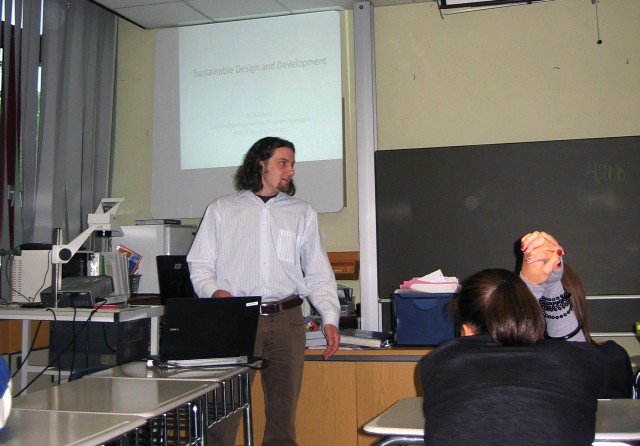WIESBADEN, Germany - "Phytoremediation" is not a term most people understand. But after a few demonstrations involving celery and water laced with food coloring, Wiesbaden High School students were able to grasp an important component of the U.S. Army Corps of Engineers' environmental clean-up program.
"The phytoremediation technology was definitely the biggest hit," said Nicole Silva, a Europe District project manager who volunteered to give presentations April 22 to local students to celebrate the 40th anniversary of Earth Day. "I think we raised not only awareness of our environmental program, but also some interest."
The idea behind phytoremediation is that pollutant--tolerant plants, if placed in an area with contaminated groundwater, will naturally soak up the chemicals mixed in with the groundwater. The plants can then be properly disposed of, thereby removing the contamination organically.
"I think the phytoremediation concept was really neat. I really enjoyed [the] example about celery soaking up the food coloring," said Katie Reynolds, a WHS sophomore whose class is currently studying watersheds and pollution migration.
Mark Ziminske, Europe District's environmental branch chief, also volunteered his time to enlighten students about modern technologies used to clean up hazardous waste sites - many that originated before strict environmental regulations were in place.
"We spend a lot of effort cleaning up fuel that has leaked into the ground and is floating on the groundwater," said Ziminske, who spoke at three science classes. "But fuel is just one example of the many contaminants that can affect our watersheds here in Europe."
Meanwhile, Rich Gifaldi, Europe District's environmental sustainability manager, presented the U.S. Army's involvement in defining, promoting and assessing green building techniques through the "Leadership in Energy and Environmental Design" system.
The presentation included current USACE projects under construction such as the 22 ultra-low energy "Passivhaus" homes currently under construction at a military housing area in Ansbach, Germany. These homes regulate interior temperature using modern technology that recovers "waste heat" from exhaust air, appliances, lighting fixtures and body heat.
"After the presentation, the students were especially interested in finding out more about the education and training needed to get a job in the field," said Gifaldi. "That made me feel like I not only did my job of explaining what we do, but I also may have started a few careers."
WHS science teacher Sue Krummrei said the presentations were ideal for a high school audience.
"The content was a very nice combination of key historical points and current challenges as well as hopeful solutions," said Krummrei.
Each spring, thousands of students learn about Earth Day and the environment through programs at Corps recreation areas and during community-sponsored Earth Day events.
"Sharing the lessons learned and the achievements that we have experienced in environmental cleanup demonstrates that U.S. Army Corps of Engineers is committed to being good stewards of the land and giving back to the community," said Ziminske. "We are very proud of what we do at the environmental office."




Social Sharing